Last night on “Late Show with David Letterman,” Sacha Baron Cohen responded to the host about his reality-based humor being difficult to pull off and dangerous to carry out in public by saying, “I won’t do it again.”
It doesn’t surprise me. What’s fascinating is finding out what amount of the shoot was planned, what was improvised, and what actually put the comedian in harm’s way. (Here is our on-camera review of “Brüno” with clips from the movie.) This press release from Universal is uncharacteristically candid about the making of “Brüno.” Sure, it’s got the normal publicist’s spin, but there’s plenty of interesting information here. It’s a look behind the scenes at this risky and fearless style of comedy. WARNING: SOME SPOILERS IF YOU HAVEN’T SEEN THE MOVIE. (Kansas City residents, scroll down to “Finding Lutz” to see what was filmed here.) Here’s the highlights:
 Following the global spotlight cast on Borat, the worldwide filmic journey of Austria’s most famous fashionista (and the host of Funkyzeit Mit Brüno) began with the filmmakers’ simple question of “Can we pull this off again?” Turns out it was possible…if they could keep their star and creative force both out of jail and alive until the end of the shoot.
Following the global spotlight cast on Borat, the worldwide filmic journey of Austria’s most famous fashionista (and the host of Funkyzeit Mit Brüno) began with the filmmakers’ simple question of “Can we pull this off again?” Turns out it was possible…if they could keep their star and creative force both out of jail and alive until the end of the shoot.
If director Larry Charles and producers Sacha Baron Cohen, Dan Mazer, Jay Roach and Monica Levinson discovered nothing else from their time on Borat, they learned to live by one rule: “Know and obey the law, and always have an escape plan.” They were sure that if Baron Cohen got arrested or hurt, the production would have to shut down and they could be delayed for weeks. That maxim informed every aspect of the production, and they were able to stick to that plan.
Well, all but once.
While the majority of films have a strict daily schedule in which cast and crew know what is expected of them, the Brüno team didn’t enjoy that luxury. Each afternoon before a day of production, the group had to determine what they would lens the next day. They plotted their course, got on the scene and shot in rapid-fire succession. Then, it was off to the next locale to push the limits without breaking the law.
Believing it was crucial to top the extreme comedy they’d achieved with Borat, the team moved the needle much further on this production and had more serious police encounters than before. It didn’t stop there. The crew found themselves receiving calls from the FBI warning of death threats and dodging clenched fists, angry mobs and loaded guns at every step of the way.
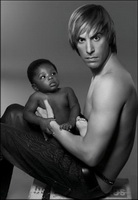 Experience from Borat had taught that the entire cast and crew had to be on board (and working with the utmost confidentiality) to make sure that the guerilla filmmaking worked. From Baron Cohen’s getting hauled away by the Milanese police after filming a show-stopping appearance at designer Agatha Ruiz De La Prada’s event to his interrogation and strip search by the officers, there was never a dull moment on the globetrotting set.
Experience from Borat had taught that the entire cast and crew had to be on board (and working with the utmost confidentiality) to make sure that the guerilla filmmaking worked. From Baron Cohen’s getting hauled away by the Milanese police after filming a show-stopping appearance at designer Agatha Ruiz De La Prada’s event to his interrogation and strip search by the officers, there was never a dull moment on the globetrotting set.
Once initial scenarios (e.g., Brüno will be tossed out of a big fashion event, flirt with shocked subjects and interview celebrities on their humanitarian efforts) were agreed upon by Baron Cohen and his fellow writers, research began to find the best venues to visit and people to experience. The results captured on film would dictate next steps.
Over the course of 19 non-consecutive weeks during an entire year, the “well-oiled and completely disorganized machine” shot footage. By staying small, stealthy and relying upon the talents of a confidential pack of people, they were able to capture what’s never been seen before on film.
Traveling in five vehicles (three vans, one getaway minivan and one RV that doubled as a production room and changing room), the cast and crew made their way across America, Europe and the Middle East. Traversing Los Angeles, New York City and Washington, D.C., to Kansas, Texas, Alabama and Arkansas in America to London, Berlin, Paris and Milan in Europe and Jordan and Israel in the Middle East, they kept an exhausting schedule. Below is only a sampling of their outrageous stories.
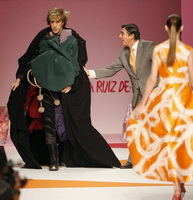 Strip Search Me: Fashion’s High Price
Strip Search Me: Fashion’s High Price
When Baron Cohen and his fellow writers imagined setting up Brüno as a reporter at a European fashion week where he would meet his Waterloo, they explored the various events that he could attend in a time frame that would work for filming. Not wanting to hedge their bets on one location, the filmmakers went to New York City, Paris and Milan and secured credentials for multiple seasons of those cities’ respective fashion weeks.
The team made it to Milan Fashion Week in late September 2008. They had imagined a gag in which Baron Cohen as Brüno would, dressed in a suit made entirely out of Velcro, exit a car outside a fashion week arena and sneak his way onto the runway; director Charles and the camera crew would capture it all. Early attempts to get into other shows failed when security recognized and banned all the key players of the production. The officers called the police and threw Camp Brüno out while they accused them of stealing clothing.
Brüno had been blackballed from Milan Fashion Week. The Italian Chamber of Fashion issued a press release to designers and warned them of the possibility Baron Cohen would try to crash their events; the chamber further advised access be denied to Brüno’s production company. With an image out on television stations and across the Internet, Baron Cohen was a man on the run. For their part, the Milanese police declared he would be arrested on sight. Everyone was looking to take down the fabulous talk-show host with the acerbic wit.
While any future attempts appeared fruitless, the team was not accustomed to throwing in the towel. Their solution? Baron Cohen insisted that they change everyone’s appearance and create an entirely new crew. Director Charles shaved his beard and modified his hairstyle; likewise, producer Mazer cut his hair, as did other members of the Milanese camera crew. Everyone involved in the final stunt changed his or her outfits.
Complete with haute couture scarves and funky glasses, they became entirely new fashionistas to fit in with the others. This would be the team’s last chance to get the Velcro scene the writers had carefully constructed. Standing between them and the stunt? Extra police and tighter security were brought in to comb the area for Brüno.
Seizing an opportunity 30 minutes before designer Agatha Ruiz De La Prada’s fashion show began, the man who created Brüno knew what he had to do. The team secured him the proper credentials, and he walked in…not as the host of Funkyzeit Mit Brüno, but in the guise of an Italian photographer in a fabulous new outfit.
Accompanied by his hair and makeup artist and co-writer Hines, Baron Cohen found a hidden nook backstage and transformed into Brüno. He attempted to reduce his rapid breathing as, inches away, models and security walked by him in disguise. The performer knew that if he were discovered that the team’s last, best chance of locking this critical scene would be over. Shortly after the show began, he seized his chance. Bursting out of his hiding place and onto the backstage, Baron Cohen sprinted past stunned models and lunged by waiting security guards.
The producers were euphoric when Baron Cohen (as Brüno in a Velcro suit covered with clothing) fell onto the runway. The crowd went wild in outrage while the cameras rolled. Just as the team caught the footage they needed, security shut the lights off and dragged Baron Cohen off the stage. Police cuffed the actor and hauled him to jail while his fellow crewmembers chased him down. Though he claimed that he’d made an honest mistake—he’d simply put on a Velcro suit and walked in—Baron Cohen was strip searched and questioned by seven police officers.
Undaunted, the team moved on to their next adventure. It wasn’t days later when Baron Cohen threw out the question: “Can we go to Paris next week for Fashion Week?” The other producers’ weary response: “Fine…we’re going to Paris!” They shot for two days in October and landed prime seating at such coveted events as Stella McCartney’s line unveiling and Jean-Charles de Castelbajac’s show. Brüno was clad in another outrageous outfit at the latter and, of course, making comments as the cameras rolled.
That was not the last that self-professed style makers would see of Brüno.
Though the sequence wasn’t used in the final cut of the film, the production shot a scene at a Berlin nightclub where Brüno gave his farewell address to the fashion world. In the middle of an all-night rave, Brüno snuck into the deejay booth, killed the music and proceeded to deliver a 10-minute speech to the bewildered patrons.
According to the delusional fashionista, his audience was the recipient of “the most important speech since Martin Luther King, Jr.’s ‘I Have a Dream.’” Needless to say, the hyperkinetic ravers did not take well to their music getting cut and began taunting the strange man giving the unsolicited lecture. Bottles and cups full of beer began pouring down on Brüno. As the nightclub’s security muscled Baron Cohen from the club, the drunken ravers began lunging after the man who had interrupted their fun. During the melee, an assailant hit the performer in the neck while others tore at his clothing.
Brüno was officially out.
When the writers were crafting Brüno’s journey, they realized he needed a partner in crime as he traveled the globe. To cast the part of the fashion host’s second assistant, the initially meek (and hopelessly in love with his boss) Lutz, the production conducted an exhaustive search; casting sessions were done in the U.S., Germany, London and multiple other locales. Lutz would be the perfect “straight man” for Brüno, going along with his insane ideas such as swindling a baby from an African tribe and trying to become heterosexual. And he did it all in the name of love.
During auditions, producer Dan Mazer recalled an actor from one of his favorite films, a Swedish comedy from writer/director Lukas Moodysson called Tillsammans (Together). He had been moved by Gustaf Hammarsten’s performance and insisted the team bring in the actor to try out for the part. When he read for the role, they knew they found their Lutz.
Along with the film’s star, Hammarsten took many risks during the shooting of the film and was an unflappable player in the troupe. From being manacled to Baron Cohen in a hotel room in Kansas City to swapping blows in an Arkansas cage match, the actor was astonishing in his versatility and bravery. And just as Baron Cohen had, Hammarsten studied German in school and knew enough to engage in conversation with Brüno in this language.
Roof Jumps and Broken Heels: Fame is Painful
In Brüno’s quest to be über famous, he would find some curious interview subjects. None were more fascinating, however, than those who should be much more media savvy: celebrities. From Paula Abdul and La Toya Jackson to Brittny Gastineau and Ron Paul, Baron Cohen managed to have singers, reality stars and politicians say and do more on camera than you can even imagine.
One of the more astonishing social experiments was the use of “Mexican Chair People.” The team had staged an outrageous gag in which Brüno realizes he has no furniture upon which to seat his subjects. What to use as chairs and benches? Latino gardeners, of course. Naturally, they didn’t expect anyone to actually sit upon the men (all of whom are stuntmen and actors) without serious pressure being applied. It proved to be stunningly easy to get compliance from the talent. Every celebrity sat right down.
American Idol judge Paula Abdul and infamous Jackson sister La Toya Jackson agreed to be interviewed by Herr Brüno and sit on the help. Both were very game to rest on the backs of the supposed day laborers. Hard to comprehend? Director Charles helps piece it together; he believes it is human nature to want to have our egos fed and we’ll forgive “small” transgressions in the process.
From his work on such films as Borat and Religulous, Charles realized that, simply put, people just want to be interviewed. With on-air talent, they believe it is part of their job to promote their project, and neither they nor their publicity team need to be too fastidious about the details.
For regular people, the rule of “everybody wants a little piece of fame” applies. With many subjects, if you put a camera in front of and a lapel mike upon them, they’ll say whatever they’re thinking for the possibility of 15 minutes of attention.
While Abdul, Jackson and Gastineau were interviewed in Los Angeles, the production spent time in Washington, D.C., to get the thoughts of a certain politico. During the time period he was running for U.S. president, Ron Paul was interviewed for the film
It was an elaborate, risky set-up on the part of the Brüno team. They had to deal with U.S. Capitol police and Secret Service, not to mention the army of handlers working with Paul. As soon as the interview wrapped (and Paul stormed off the set), Baron Cohen was whisked out of the suite, into a fake police car, and onto a flight headed for New York City.
The arduous work of shooting Brüno finally took its toll. The performer was bedded by a case of the flu and wasn’t permitted to fly. Production had to shut down for two days. Though not fully recovered, he was propped up long enough to shoot the Mexican Chair bit, then flown to Kansas for integral scenes in which he was manacled to Gustaf Hammarsten as they made their way through a hotel and a mall.
During the hotel room scene in which Baron Cohen and Hammersten were chained together on the bed, word arrived that the police were in the lobby. As Kansas City’s finest rode up the elevator, both men made a mad dash down the emergency exit staircase. To their alarm, they discovered the staircase ended at the second story. They were trapped.
It was time to choose between facing the police (read: possible arrest and deportation for the Europeans) and a 15-foot leap to freedom. Both men took the plunge and fled into the escape vehicle.
Baron Cohen was officially down for the count. His antibiotics gave him thrush. The hair depilatory he was using gave him a strong reaction. After recovering from sinus infections, and forcing himself to recover, Brüno was back in action. Until his alter ego broke a heel while wearing platform boots during a Stunt in the Midwest and production had to shut down for another seven weeks.
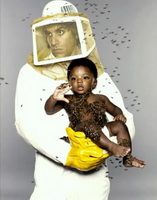 Terrorists to Supremacists: Engaging Fundamentalists
Terrorists to Supremacists: Engaging Fundamentalists
While director Charles and the other producers learned to expect the unexpected when it came to the mind of Sacha Baron Cohen, one thing they were not prepared for was the actor’s intentions for Brüno to help negotiate peace in the Middle East.
The production’s general policy for interviews is that Baron Cohen allows subjects to keep going and give the most honest reaction they can to the scene he’s created with his fellow writers. With the suggestion that the company mingle with terrorists, however, the reaction among the normally brave key players was: “How the hell are we going to be do this and not get everyone killed?” They knew they couldn’t safely go to Jordan, Israel or the West Bank to set these up.
Well, at least that’s what they thought.
Before they embarked upon the plan, the team met with Middle East experts to learn what lines could never be crossed; they engaged the help of key Palestinian, Jordanian and Israeli advisors to understand these unwritten codes of conduct. Whether they followed them, however, was another story.
This region proved to be the most intimidating and life-threatening location in which the team would shoot. After slyly getting the former Jordanian prime minister to take part in a 90-minute interview at his home, Baron Cohen needed to meet with the country’s royal family to smooth things over. And if that—coupled with engaging members of Mossad and other fundamentalist politicians in the region—wasn’t enough, Baron Cohen as Brüno headed to an area of the West Bank (in Zone C) that is not under Israeli control. If anything went wrong, there would be no help from the Israeli army. The filmmakers were truly on their own.
Surprisingly, the head of the Bethlehem unit of terrorist group al-Aqsa Martyrs’ Brigade agreed to meet with this correspondent. The leader of a sect known for suicide bombings sat with Brüno while an aide translated curious, highly offensive statements from the interviewer. And while they spoke, they were surrounded by the terrorist’s bodyguards…who grew more and more agitated by the barbs.
Once Baron Cohen and Charles arrived at the secret location in the West Bank, they were informed that Palestinian intelligence knew they were there and were keeping an eye on their every movement. With no time to waste, the team got the footage they needed and quickly headed back into protected territory.
What peace process would be complete without getting feedback from the other side? One of the more rapid experiments for the production was Brüno’s sashay through a Hasidic neighborhood in Israel. Among this conservative community, men and women are forbidden from showing much skin (including legs and arms). In retaliation for his offenses, furious members of the crowd chased Baron Cohen after Brüno took a stroll in skin-tight short shorts and a Little Debbie-inspired bonnet.
They were out for blood. A large, angry crowd of Hasidic Jews began to gather, intent upon harming Baron Cohen for his actions. The performer was forced to hide in the store of a compassionate shopkeeper until a van could reach him and assist his getaway. Only then could he hunch down on the floor of the getaway vehicle and avoid the growing potential riot situation.
Back in the U.S., the production assumed it would be on safer ground. Wrong. They engaged with a domestic terrorist who was as dangerous as any they’d encountered overseas. While the scenes they shot didn’t make it into the final cut of Brüno, the team lensed at a prominent white supremacist’s house. The man who had spent a decade in prison for violent hate mongering did not take it very well when Brüno introduced him to his then-gay lover, Diesel. The supremacist cocked his fist and went to attack Baron Cohen, who was able to avoid his punch and make it safely out of the house.
 Ruthless Stage Parents
Ruthless Stage Parents
Another area of interest to the team was the worldwide fascination with celebrities’ lives and the mixed messages performers give when showcasing their families to an eager public. The creative team realized that if Brüno tried to appear to be a selfless, doting father, he could (in his mind) vault his status in the celebrity community.
Naturally, he should adopt a child. And what could make him seem to be a more caring, famous parent than bringing an African baby from a tiny village into his unorthodox home? If Madonna and Angelina could do it, so could Brüno.
Much like a fashion accessory, Brüno would cart his adopted son (played by twin boys) everywhere he went…from casting sessions and impromptu weddings in California to talk shows in Texas. Of course, the boys’ parents and a social worker became part of the camp’s lean team and provided support for the twins at every step of the way.
Nowhere was he a bigger surprise, however, than at the Dallas-Fort Worth international airport. While director Charles shot the scene and fliers’ reactions, Brüno and his assistant pretended to pick up his newly arrived child from the baggage carousel. The jetsetter had just been on an African safari, and this child was his most precious and fantastic new souvenir.
However, Brüno was not the only one who wanted to be a superstar.
Few find the quest for fame as enticing as some parents of aspiring child actors. The filmmakers wanted Baron Cohen as Brüno to examine the players of that world, and he conducted multiple casting sessions with caregivers of “aspiring” child actors in Sherman Oaks, California, in February 2008. Interviewees were instructed that their children were being considered for an upcoming photo shoot with the host’s baby. For all involved in the production, it was stunning to listen to the bizarre and dangerous lengths to which some parents would go for their children to become a part of the public eye.
When it was Brüno’s time in front of the camera, Baron Cohen posed ever-more exaggerated questions to find out the extent to which these parents would allow their children to be in jeopardy. After the performer wrapped the final auditions, the team was so unnerved by the parents’ bizarre reactions to increasingly shocking scenarios that they made sure the eager parents didn’t follow through. Members of the team called and advised the eager stage moms and dads that they shouldn’t proceed as if their child got the part; he or she wouldn’t be a part of a photo shoot.
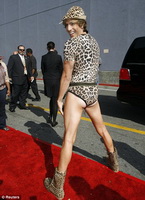 Locked and Loaded: Hunting Brüno
Locked and Loaded: Hunting Brüno
When he began production of Da Ali G Show several years ago, Sacha Baron Cohen believed he would have to use all his improvisational skills to lead people down a path and get them to react for the camera. Turns out he was quite wrong. Much goading or antagonism wasn’t necessary at all. He found that once interviewees had a lens in front of them and were prompted with uncomfortable scenarios, they reacted incredibly honestly. People don’t say or do things on camera that they don’t mean.
Likewise, director Charles and the producers were fascinated to realize the levels of anger that came when some subjects were confronted with Brüno’s homosexuality. A simple act such as a kiss between two men enraged certain people, and all their reactions were caught on camera. Sometimes, they were infuriated to the point that they wanted to physically harm Baron Cohen.
This was most definitely the case when traveling with four hunters in Alabama. The men agreed to take the foreign correspondent and his crew along with them as they went hunting, but they wouldn’t be giving up their guns at any point. The crew attempted to get the men to relinquish their weapons during filming, but that wasn’t as easy as it sounds. In fact, when things got heated, guns got drawn.
Once the hunters realized Brüno was gay and believed he was hitting on one of them, they readied their rifles. The production found itself in a standoff in the dark with armed men who were growing increasingly agitated by Baron Cohen’s pranks. The hunters were stewing by the time the team pulled up stakes, and their reactions were soon reaching a boiling point. During one discussion, one of the men actually pulled a weapon on a crewmember and pointed it at him.
It was time to get out of Dodge.
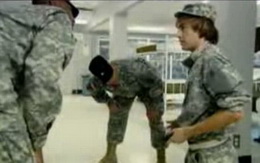 Don’t Ask, Don’t Tell: Breaching National Security
Don’t Ask, Don’t Tell: Breaching National Security
After Brüno decides he must become straight to find fame, he goes on a cross-country journey to eradicate any hint of his homosexuality. A logical stop to do such complicated work? The U.S. Army National Guard headquarters in Anniston, Alabama, about 65 miles from Birmingham. Unfortunately, this unit of the National Guard was unable to guard its own base from one canny British infiltrator.
The production lucked into the scenario when they asked a contact at the National Guard if the production could imbed on-air talent for the day. They explained that the purpose of the visit was to let their audience know what it was like to live and work as a candidate in officer training school. While there, Baron Cohen, dressed in the latest style of fatigues (read: Dolce & Gabbana), perplexed his fellow soldiers with his stunts.
It was not one of the finer days for national defense. When the production’s van came into the training ground, no one was asked for identification. Oddly enough, it turned out to be the perfect storm of confidentiality for the team, as the younger recruits were not allowed to speak freely unless they received the go-ahead by a commanding officer. If they had given permission earlier, the senior members would have known what several of the 20- to 22-year-old guys did: The man behind Borat was in their midst.
Once the crew heard the buzz that some of the young men suspected Baron Cohen was there, they packed up the team and got them out ASAP. As they were loading the performer into the van and driving rapidly off the base, the guards yelled out for them to stop and began to close the gate. Ten seconds too late, as Brüno (and the perfect amount of footage of his acting up during officer training school) were out the door. Had the team been moments later in their exit, the National Guard could have confiscated the tapes and they wouldn’t have seen the light of day.
When finally confronted with the question of “Did you know who that trainee was?,” the recruits responded with a firm: “Yes, sir! Sacha Baron Cohen, sir!”
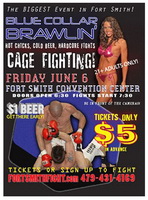 Dangerous Cage Fights: Unmasking Homophobia
Dangerous Cage Fights: Unmasking Homophobia
Aside from interviewing the terrorist leader in the Middle East, one of the most dangerous stunts during the production was the cage fight in which Brüno realizes the love of his life is in the ring with him. As they ensured during most scenes shot for the film, director Charles and the producers booked a back-up venue in case they didn’t get the right material on the first day of shooting. If needed, they could intercut with footage and salvage the bit. They knew that once word was out that the production was in town, it would spread like wildfire; they had to stay one step ahead of the public.
Nowhere did the filming get more dangerous, however, than when interviewees and other subjects of the film saw the relationship develop between Brüno and his traveling companion, Lutz.
In early June 2008, the production worked with a venue in Texarkana, Arkansas, to host a night of “Blue Collar Brawlin’” in which audiences would watch ultimate wrestling and get cheap beer. Brüno, transformed from hard months of life on the American roads learning how to be heterosexual, would battle it out with anyone who dared to challenge the macho man he’d become. This set-up would involve pushing the strict local and state morality standards to the edge.
It was vitally important for the production to avoid breaking any statutes or codes, and they always made certain they were on the right side of the law. As well, the team didn’t want to take chances with angry officers and made every effort to keep the police apprised and on their side. It didn’t hurt, however, to know they were close enough to two other states if they had to escape Texarkana.
The first night, the venue in Southwestern Arkansas would initially only supply police to serve as the arena’s security guards. But once the production told the officers that the audience might get unnerved when—during the course of the evening’s entertainment—two men kissed, the police reply was that they wouldn’t cover the event. They would, however, come back if any audience members called in a complaint and problems arose. And did they ever.
The cast and crew were now on their own.
As a producer, writer, creator and star of the comedy, Baron Cohen knew that it would be impossible for him to perform in character if he was concerned about his team’s safety. Moments after the first embrace between the two men, chairs were pulled up and tossed, a fighter who had been watching from the audience climbed into the cage and challenged Baron Cohen to a fight. Director Charles got none of the footage he needed, but Baron Cohen and the crew escaped just in time. The police did not return to the scene.
Overnight, they moved the entire operation several hours to the north to Fort Smith, Arkansas. Once there, the Brüno team was contacted by the Fort Smith police about what happened in Texarkana; these officers were reluctant to cover the event. As police were the only security certified to man the convention center, the production thought they were out of luck. Fortunately, the producers met with the chief of police and several other officers to secure the clearance needed. They left the meeting armed with a list of city ordinances that were stricter than the Arkansas state rules.
Lessons learned, for the Fort Smith event, the team made sure there were no glass bottles that could be used as projectiles, and they wired chairs together so fans couldn’t pick them up and lob them into the ring.
Seconds after the kiss, attendees became furious. Soon after, one member of the crowd unwired a chair and threw it at Baron Cohen’s head. At that point, it was a near riot and the performers were rushed from the premises. Audience members and other fighters alike were screaming epithets and surrounding the bus and the field team. It ended after a stand off that lasted many hours, with 40 police officers from the Fort Smith division helping to rescue the cast and crew and quell the angry mob.




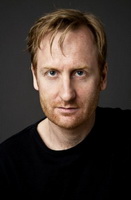




{ 4 comments }
VERY excited for this movie and it was definitely exciting to see the amount of detail that went into something like this. After this movie Sacha will really never need to be in harms way like that again
VERY excited for this movie and it was definitely exciting to see the amount of detail that went into something like this. After this movie Sacha will really never need to be in harms way like that again
Good video review. “With Black dildos in their face.” HA HA HA
Good video review. “With Black dildos in their face.” HA HA HA
Comments on this entry are closed.